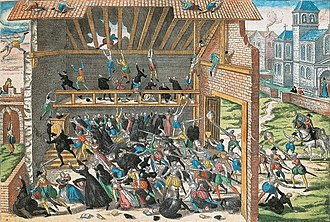 The Massacre of Wassy, also known as the Massacre of Vassy, is the name given to the murder of Huguenot worshipers and citizens in an armed action by troops of Francis, Duke of Guise, in Wassy, France on 1 March 1562. The tragedy is identified as the first major event in the French Wars of Religion. The series of battles that followed concluded in the signing of the Peace of Amboise (or Pacification Treaty of Amboise) the next year, on 19 March 1563.
The Massacre of Wassy, also known as the Massacre of Vassy, is the name given to the murder of Huguenot worshipers and citizens in an armed action by troops of Francis, Duke of Guise, in Wassy, France on 1 March 1562. The tragedy is identified as the first major event in the French Wars of Religion. The series of battles that followed concluded in the signing of the Peace of Amboise (or Pacification Treaty of Amboise) the next year, on 19 March 1563.
The events surrounding the Massacre of Wassy became widely known by a series of forty engravings published in Geneva seven years later.[1]
History
Massacre]After the ascent of Henry II to the French throne, followers of the religious teachings of John Calvin, known as Huguenots, were persecuted in France. Catherine de' Medici, regent of Charles IX, proposed the Edict of January (or Edict of Saint-Germain) with the hopes that Calvinism and Catholicism could co-exist in France and that fighting would cease.
On 1 March 1562, Francis (François), the second Duke of Guise, travelling to his estates, stopped in Wassy (aka Vassy) and decided to attend Mass. He found a large congregation of Huguenots holding religious ceremonies in a barn that was their church. Some of the duke's party attempted to push their way inside and were repulsed. Events escalated, stones began to fly, and the Duke was struck. Outraged, he ordered his men to fortify the town and set fire to the church, killing 63 unarmed Huguenots and wounding over a hundred.[2]
Aftermath
The massacre provoked open hostilities between some followers of each religion, sparking the first war of a long series of French Wars of Religion, which continued largely uninterrupted for more than a century.[3]
The Bourbons, led by the Prince of Condé, and proclaiming that they were liberating the king and regent from "evil" councillors, organised a kind of protectorate over the Protestant churches and began to seize and garrison strategic towns along the Loire. Although the Huguenots had begun to mobilise for war before Vassy,[4] Condé used the massacre as evidence that the Edict had been broken, lending further weight to his campaign, and as hostilities broke out, the Edict was in fact revoked under pressure from the Guise faction.
The major engagements of the war occurred at Rouen, Dreux and Orléans. At the Siege of Rouen (May–October 1562), the crown regained the city at the cost of Antoine de Navarre, who died of his wounds. The Battle of Dreux (December 1562), saw the capture of Condé by the Guises and Montmorency, the governor general, by the Bourbons.
In February 1563, at the Siege of Orléans, Francis, Duke of Guise was shot and killed by the Huguenot Poltrot de Méré; the Guise considered this an assassination on the orders of the duke’s enemy, Admiral Coligny, as it was outside of direct combat. The popular unrest caused by the 'assassination', coupled with the fact that Orléans was holding out in the siege, led Catherine to mediate a truce and the Edict of Amboise (1563).
No comments:
Post a Comment